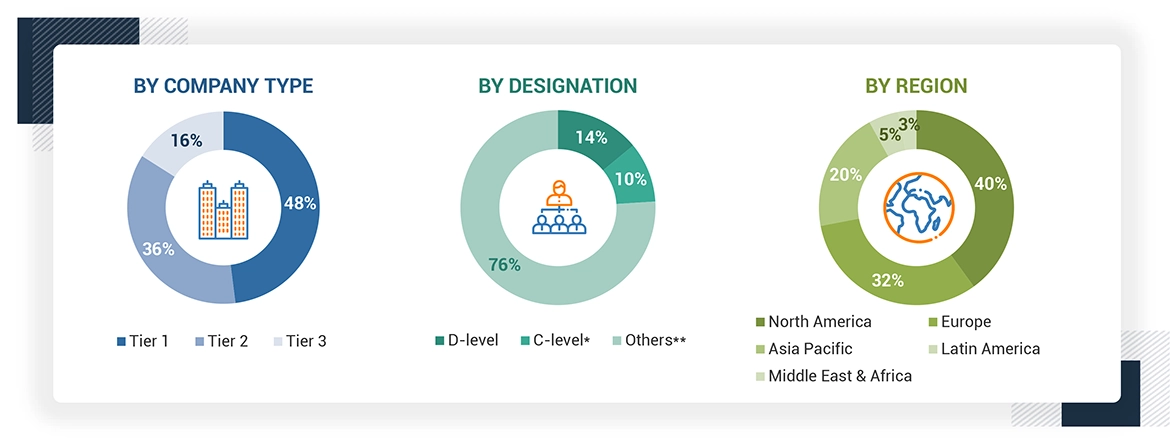This study involved four major activities in estimating the current size of the compression therapy market. Exhaustive secondary research was done to collect information on the market, peer market, and parent market. The next step was to validate these findings, assumptions, and market sizing with industry experts across the value chain through primary research. Both top-down and bottom-up approaches were used to estimate the total market size. After that, the market breakdown and data triangulation were done to determine the market size of the segments and sub-segments.
Secondary Research
The secondary sources referred to in this research study include corporate filings (such as annual reports, SEC filings, investor presentations, and financial statements); research journals; and press releases; trade, business, and professional associations. Secondary sources were used to identify and collect useful information for this extensive and commercial study of the compression therapy market. Secondary research was mainly used to obtain key information about the industry’s total pool of key players, market classification and segmentation according to industry trends to the bottom-most level, market trends, and critical developments by both the public and private organizations in the compression therapy market.
The secondary sources referred to for this research study include government sources, independent or public sources, paid/private databases, and research databases, among others. Secondary data was collected and analyzed to arrive at the overall market size of the compression therapy market, which was further validated by primary research. Some of the key secondary sources referred to during the preparation of this report are listed below-
-
Governmental and Intergovernmental Sources & Databases such as World Health Organization (WHO), World Bank, Organisation for Economic Co-operation and Development (OECD), Centers for Disease Control and Prevention (CDC), National Health Service (NHS) among others
-
Business and Research Articles: Springer Nature, The Lancet, PubMed, and US National Library of Medicine, among others
-
Company Sources: Annual reports, SEC filings, regulatory filings, investor presentations, press releases, and financial statements, among others.
Primary Research
Extensive primary research was conducted after acquiring knowledge about the compression therapy market scenario. The compression therapy market comprises several stakeholders, such as end-product manufacturers, raw material providers, and end-users in the supply chain. The demand side of this market is characterized by its end-users, such as hospitals & clinics, pharmacies and retailers, e-commerce platforms, among others. The supply-side is characterized by raw material providers, integrators, and others. Various primary sources from both the supply and demand sides of the market were interviewed to obtain qualitative and quantitative information.
A breakdown of the primary respondents is provided below:

*C-level primaries include CEOs, CFOs, COOs, and VPs.
**Others include sales managers, marketing managers, business development managers, product managers, distributors, and suppliers.
Note: Companies are classified into tiers based on their total revenue; as of 2021, Tier 1 = >USD 10 billion, Tier 2 = USD 1 billion to USD 10 billion, and Tier 3 = < USD 1 billion.
Source: MarketsandMarkets Analysis
To know about the assumptions considered for the study, download the pdf brochure
Market Size Estimation
Both top-down and bottom-up approaches have been used to estimate and validate the size of the compression therapy market and its dependent submarkets. These methods were also used extensively to determine the extent of various sub-segments in the market. The research methodology used to estimate the market size includes the following:
-
The key players in the industry and demand have been identified through extensive secondary research, and their market share has been determined through both primary and secondary research.
-
The industry’s supply chain and market size, in terms of value, have been determined through primary and secondary research processes.
-
All percentage shares, splits, and breakdowns have been determined using secondary sources and verified through primary sources.
-
All the possible parameters that affect the market segments covered in this research study have been accounted for, viewed in extensive detail, verified through primary research, and analyzed to get the final quantitative and qualitative data.
-
The above-mentioned data was consolidated and added with detailed inputs and analysis from MarketsandMarkets and presented in this report.

Data Triangulation
After arriving at the overall market size—using the market size estimation processes as explained above—the market was split into several segments and subsegments. To complete the whole market engineering process and arrive at the exact statistics of each market segment and subsegment, data triangulation, and market breakdown procedures were employed, wherever applicable. The data was triangulated by studying various factors and trends from both the demand and supply sides in the end-use industries.
Report Objectives
-
To define, describe, and forecast the compression therapy market based on product, technique, application, distribution channel, and region
-
To provide detailed information regarding the major factors influencing the growth of the market (such as drivers, restraints, opportunities, and challenges)
-
To analyze the micromarkets with respect to individual growth trends, prospects, and contributions to the overall compression therapy market
-
To analyze the opportunities for stakeholders and provide details of the competitive landscape for market leaders
-
To forecast the revenue of the market segments with respect to five major regions and their countries—North America, Europe, the Asia Pacific, Latin America, and the Middle East & Africa
-
To strategically profile the key global players and comprehensively analyze their market shares and core competencies
-
To track and analyze competitive developments such as product launches, upgrades, and approvals; partnerships, agreements, and collaborations; acquisitions; and expansions in the compression therapy market
-
To benchmark players within the market using the proprietary Competitive Leadership Mapping framework, which analyzes players on various parameters within the broad categories of business and product excellence strategy



Fiona
May, 2022
Global Compression Therapy Market Size, Forecast 2026. Its data on Market Projection By Technology, Major key players, Growth, Revenue, CAGR, Regional Analysis, Industry Forecast.
Edward
Jun, 2022
Can you share more about how key players are able to retain their position in the global Compression Therapy Market?.